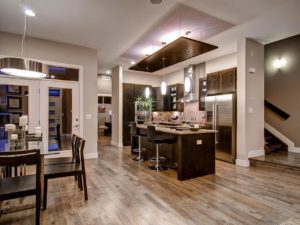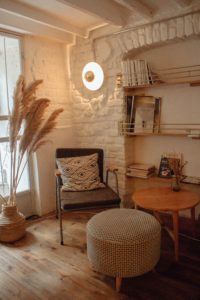Today’s homes multi-task as offices, school rooms, and play areas. The latest home design trends aim to support these functions while still delivering fabulous style. Top 2021 trends in design cover the gamut from hardwood floors to lighting. If you’re spending more time at home, you’ll love this list of ideas for updating and refreshing your space.
Go Luxe With Navy Blue
In the past, designers used black accent walls, furnishings, and fixtures to lend glamour and sophistication to a living area. In 2021, navy blue is the new black for interior designs. Navy appears softer than black and coordinates with many colors without looking too harsh.
Navy blue enhances both contemporary and traditional living rooms. You’ll find the color splashed on accent walls with paint or pretty wallpaper prints. Get a thoroughly modern living room makeover with chairs and sofas that are upholstered in this velvety, rich color.
Brighten Rooms With Light Floors
You can’t broach the subject of interior design without challenging your flooring choices. If you love modern elements for your home, our designers recommend lighter flooring options. Light-colored floors work well with Scandinavian-style furnishings and fixtures. They also give industrial living areas a more spacious and bright look.
When creating modern interior designs, hard floors take center stage. You’ll see sealed concrete and natural stone tile floors throughout 2021’s modern homes. Hardwood flooring is a classic option that never goes out of style, and it has a wide appeal with both homeowners and home shoppers. Some hot hardwood species to consider for 2021 include white oak, birch, and ivory maple.
Modern Rustic Design Combos
If you and your spouse bicker about the benefits of modern over rustic interior design, 2021 can be a game changer for your relationship and your home’s look. Home design experts mix modern and rustic furnishings and fixtures for distinctive design combinations in 2021. There are several ways that you can get the look without making your home a total construction site.
If your spouse won and you’re starting with a completely modern living area, add some rustic elements to the space such as a sliding barn door, rough-hewn wood sconces, or a hand-made, glass-topped wooden table. Many modern spaces rely on bright, white walls as a backdrop for minimalist drama. By adding elements of dark, natural wood, you give the space a pleasant surprise with color contrasts and texture mixes.
Completely rustic spaces benefit from modern touches as well. The best way to pull off this look is by introducing sleek, natural elements into the space. Consider incorporating things such as stainless steel countertops, shiny metal-framed side tables, and lots of glass.
Get Glowing With Hidden Lighting
Lighting is the unsung hero of great interior design. With the right lights, you can make a space appear larger or smaller than it really is. You can also create a warm, elegant ambiance for a space, which is desired in both modern and traditional designs. Hidden lights top the list of 2021 trends in home lighting.
Hidden lighting goes beyond the standard recessed lights of the past. You’ll often see diffused, soft light coming from above a fixture or from its side, but you can’t see the source of the light. Hidden lights such as positional luminaries and multi-level lighting are found integrated into ceilings, walls, and floors.
Bring Indoor Comforts Outdoors
Our current pandemic situation makes a comfortable outdoor living area a must-have part of any interior design in 2021. Even if you don’t have the space or the budget for a complete outdoor living room, you can still enjoy the trend with a few decorative, weather-proof chairs, comfortable textiles, and some paint. Consider painting your porch a soothing color that you would see in an interior room such as slate blue or one that’s found in nature such as forest green. Adorn chairs with cheerful-looking cushions, lay out some textured throw rugs, and grab a cup of your favorite herbal tea for a delightful getaway without getting away.
Improve Productivity With More Storage Cabinets
If you’re working from home and/or home-schooling children, your quality of life can be affected if you’re not organized. A top 2021 trend in home design is adding more storage cabinets in your living and work spaces. By installing storage cabinets that match your room’s decor, you’ll declutter, reclaim space, improve your concentration, and increase your room’s aesthetic appeal.
Indulge in Sustainable Minimalism
Two of interior designers’ top loves have come together to form a leading home design trend for 2021. Minimalism in furniture, fixtures, and architectural design isn’t going anywhere in 2021. However, it’ll have a sustainable twist. You’ll find light fixtures with simple lines that are made of recycled materials. Cork and bamboo floors are set to be favorite options for those who want to incorporate sustainable minimalism design elements into their homes in 2021.
Conclusion
Quality flooring is the foundation of every distinctive interior design. Whether you’re the parent of a toddler who needs soft carpet for her first steps or you’re a senior who has a passion for exotic hardwood floors, Classic Floor Designs delivers on quality, style, and function. Call us today at 202-872-9860 to schedule your free design consultation.





